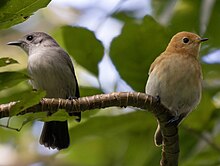
Aerodramus is a genus of small, dark, cave-nesting birds in the Collocaliini tribe of the swift family. Its members are confined to tropical and subtropical regions in southern Asia, Oceania and northeastern Australia. Many of its members were formerly classified in Collocalia, but were first placed in a separate genus by American ornithologist Harry Church Oberholser in 1906.

The monarchs comprise a family of over 100 passerine birds which includes shrikebills, paradise flycatchers, and magpie-larks.

The Indian paradise flycatcher is a medium-sized passerine bird native to Asia, where it is widely distributed. As the global population is considered stable, it has been listed as Least Concern on the IUCN Red List since 2004. It is native to the Indian subcontinent, Central Asia and Myanmar.
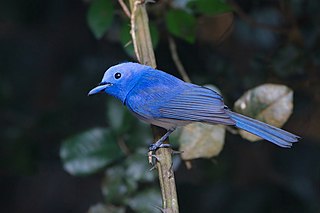
The black-naped monarch or black-naped blue flycatcher is a slim and agile passerine bird belonging to the family of monarch flycatchers found in southern and south-eastern Asia. They are sexually dimorphic, with the male having a distinctive black patch on the back of the head and a narrow black half collar ("necklace"), while the female is duller with olive brown wings and lacking the black markings on the head. They have a call that is similar to that of the Asian paradise flycatcher, and in tropical forest habitats, pairs may join mixed-species foraging flocks. Populations differ slightly in plumage colour and sizes.

The orange-bellied parrot is a small parrot endemic to southern Australia, and one of only three species of parrot that migrate. It was described by John Latham in 1790. A small parrot around 20 cm (8 in) long, it exhibits sexual dimorphism. The adult male is distinguished by its bright grass-green upper parts, yellow underparts and orange belly patch. The adult female and juvenile are duller green in colour. All birds have a prominent two-toned blue frontal band and blue outer wing feathers.

The paradise flycatchers (Terpsiphone) are a genus of birds in the family Monarchidae. The genus ranges across Africa and Asia, as well as a number of islands. A few species are migratory, but the majority are resident. The most telling characteristic of the genus is the long tail streamers of the males of many species. In addition to the long tails the males and females are sexually dimorphic and have rufous, black and white plumage.

The Australian rufous fantail is a small passerine bird, most commonly known also as the black-breasted rufous-fantail or rufous-fronted fantail, which can be found in Australia.
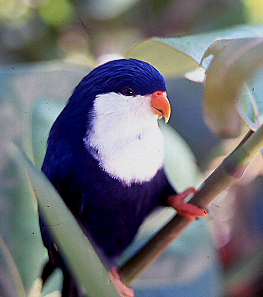
The blue lorikeet is a small lorikeet from French Polynesia and the Cook Islands. It is also known as the Tahiti lorikeet, violet lorikeet, Tahitian lory, blue lory, nunbird, and the indigo lory. It was formerly found on 23 islands around Tahiti, but now restricted to perhaps eight islands: Aitutaki, Apataki, Arutua, Kaukura, Manuae, Maupihaa, Motu One, Rangiroa, and possibly Manihi and Manuae. Its plumage is mainly dark blue and it has a white area over its upper chest, throat and face. The first captive breeding in the UK was by the Marquess of Tavistock in the 1930s. He was awarded a silver medal by the Foreign Bird League for this achievement.
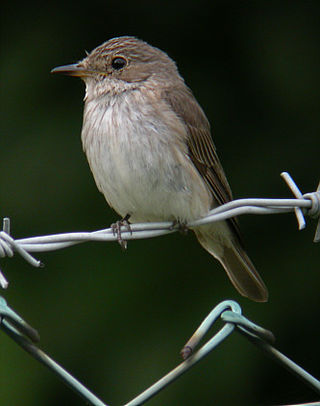
Muscicapa is a genus of passerine birds belonging to the Old World flycatcher family Muscicapidae, and therein to the typical flycatchers of subfamily Muscicapinae. They are widespread across Europe, Africa and Asia with most species occurring in forest and woodland habitats. Several species are migratory, moving south from Europe and northern Asia for the winter.

Kuhl's lorikeet (Vini kuhlii), also called the Rimitara lorikeet, Kuhl's lory, Manu 'Ura (local appellation) or Kura (Cook Islands), is a species of lorikeet in the family Psittaculidae. It is one of several species of Vini lorikeets found in islands ranging across the South Pacific. The Kuhl for whom Nicholas Aylward Vigors named the bird in 1824 was Heinrich Kuhl, a German ornithologist whose survey of the parrots, Conspectus psittacorum, had appeared in 1819.
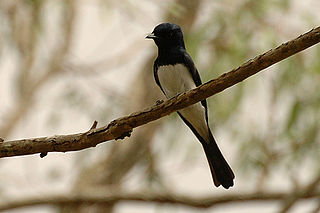
The satin flycatcher is a species of bird in the family Monarchidae. Males stand out with their blue-black feathers contrasting their white bellies, and the females with their bright orange throats. It breeds mostly in south-eastern Tasmania and Australia. It is declining throughout the eastern seaboard due to predation from the introduced Red Fox and habitat loss. It is a vagrant to New Zealand.
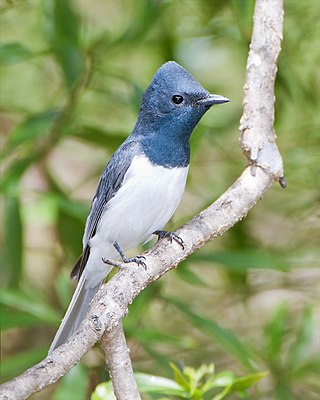
The leaden flycatcher is a species of passerine bird in the family Monarchidae. Around 15 cm (6 in) in length, the male is lustrous azure with white underparts, while the female possesses leaden head, mantle and back and rufous throat and breast. It is found in eastern and northern Australia, Indonesia, and Papua New Guinea. Its natural habitat is subtropical or tropical mangrove forests in the northern parts of its range, in the south and inland it is eucalypt woodland.
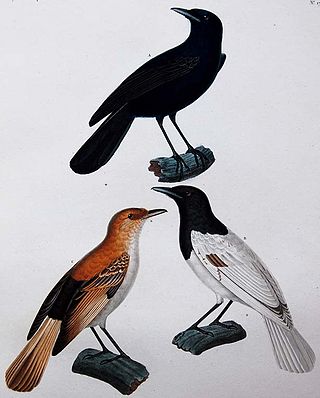
Pomarea is a genus of birds in the monarch flycatcher family Monarchidae. The genus is restricted to the islands of Polynesia. The monarchs of this genus are around 15–19 cm long and most have sexually dimorphic plumage.
The Marquesan monarch is a species of bird in the family Monarchidae. It is endemic to French Polynesia. Its natural habitats are subtropical or tropical dry forest, subtropical or tropical moist lowland forest, and subtropical or tropical moist montane forest. It is threatened by habitat loss.

The Tahiti monarch, or Tahiti flycatcher, is a rare species of bird in the monarch flycatcher family. It is endemic to Tahiti in French Polynesia. There are between 25 and 100 individuals remaining with an increasing population trend. Adults boast a striking black plumage with pale blue pills and feet. Recognized for its melodious flute-like song and distinctive "tick-tick-tick" call, it thrives in dense forest, primarily inhabiting canopy and understory amidst native mara trees. Despite facing threats from introduces predators such as ship rats and invasive bird species, conservation efforts have been implemented to safeguard its population.
The Te Ipukarea Society (TIS) is an environmental non-government organisation based in the Cook Islands of Polynesia in the south-western Pacific Ocean. The original name was Taporoporo'anga Ipukarea Society, but was shortened a number of years ago to make it easier to pronounce. An approximate translation of the name from Cook Islands Māori is "looking after our heritage". It is the BirdLife International partner organisation for the Cook Islands, and also a member of the International Union for Conservation of Nature.
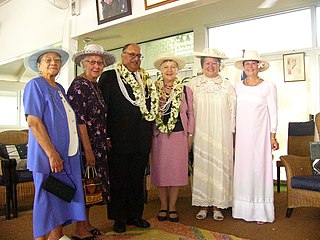
Dame Margaret Makea Karika Ariki, also known as Pauline Margaret Rakera George Karika and Pauline Margaret Rakera Taripo, was a Cook Islands ariki and holder of the Makea Karika Ariki title from 1949 to 2017. She was President of the House of Ariki from 1978 to 1980, and again from 1990 to 1992. She also served in the Legislative Assembly from 1958 to 1961.
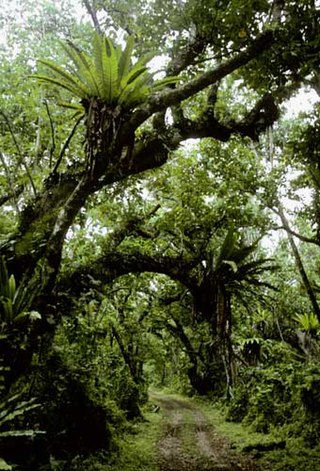
The Cook Islands tropical moist forests is a tropical and subtropical moist broadleaf forests ecoregion that covers the Southern Cook Islands in the Cook Islands.
